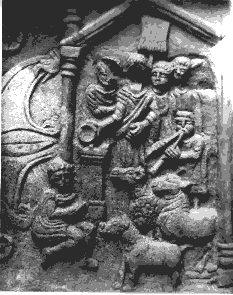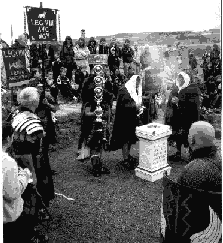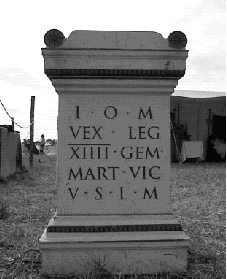Religion
|
|
| Religion was a vital part of Roman army life but is also one that is relatively neglected in both the secondary literature and the Roman military re-enactment scene. Because of this the Roman Military Research Society, inspired in part by a festival held by the Quinta Gallorum, decided to construct an altar to Jupiter Optimus Maximus and to develop a ceremony of worship and propitiation based on ancient texts and original formulae. It is interesting to note that the earliest Roman religious ceremonies did not necessarily rely on the sacrifice of animals but on offerings of wine, incense and foods such as libum, a wheaten cake, and these are consequently our preferred offerings. The Signifer and Centurio of the unit officiate at these ceremonies and, although we take them seriously, participation does not necessarily imply belief, as indeed was the case in antiquity. Public involvement was a demonstration of loyalty and commitment to one's Legion and to Rome. The same applies today | |
|
Moribus antiquis stet res Romana. (Ennius) Roman state religion had always been a vital part of public life; a means both of securing divine assistance for the state's endeavours and a way of affirming public loyalty . This was appreciated very clearly by the Emperor Augustus whose political 'revival' of the Republic also encompassed a restoration of ancient religious cults, ceremonies and festivals. The one required the other. In fact, this was as true of the newly reconstituted army as it was of the civil administration. It could, indeed, be argued that the development of a military religious tradition was even more significant since Augustus, and every subsequent Princeps, relied fundamentally on a loyal army for political power. Religious observance was one crucial way of sustaining that loyalty and power through a celebration of shared pietas . This fostering of loyalty to state and Emperor could operate in a number of different ways: in the annual oath taken to the Emperor of the day by his loyal soldiery ( something still done by the modern Legio XIIII GMV) ; in the yearly dedication of a new altar to Jupiter Optimus Maximus, father of the Roman state and protector of its soldiery, (as at Maryport in Cumbria); in offerings to the Imperial genius or numen or to the Disciplina Augusti or indeed in the numerous festivals that punctuated the military year. Yet to regard the cults of the Roman army as simply a cynical political exercise is to miss the realpoint. Shared religious observance was a means of developing and strengthening a vital esprit de corps - as was reverence shown to the standards which, although not worshipped as such, were the embodiment of the spirit or genius of the unit, being kept in an aedes, or chapel alongside the image of the Emperor and other sacred objects, and always being treated with due respect and reverence. To lose one's standard was the worst ignominy that could befall a military unit, as Crassus and Varus ought to have known. In the uncertainty of battle, reassurance from the haruspex ( literally "gut gazer") that the omens were good or that Jupiter, suitably fed and watered, was watching over you ready to hurl his thunderbolts at the enemy must have been particularly welcome to hard pressed squaddies. Jupiter, of course, was not alone on Mt. Olympus and no-one would object to a soldier's additional personal devotion to any of the myriad deities found across the Roman world- the more, the merrier was a basic philosophy. The more divine insurance a man had the better and if Jupiter couldn't help, then perhaps Mars Cocidius or Apollo Cunomaglus or, latterly, Mithras, Sol Invictus, could. Traditional Roman religion was essentially contractual and had very little to do with personal salvation. II you needed divine assistance, then you prayed to your chosen deity and promised to make them an offering- an animal sacrifice, perhaps, an altar, or a sacred object to beautify a temple in return for their help in achieving the desired end. Then you sat back and waited for your prayers to be answered. This must have happened frequently as a large number of inscriptions have survived bearing the traditional formula "VSLM" . - votum solvit libens merito .. (he or she) "freely and willingly fulfilled their vow" This same formula can be found on our altar whilst our prayers reflect the debt of gratitude owed to Jupiter, Best and Greatest for his assistance in previous victorious military campaigns and ask that such help may also be vouchsafed in the future. |
|
 |
|
| Antonine Wall
distance slab from Bridgeness showing army religious ceremony in progress. 2nd cent. AD (Hunterian Museum), Glasgow) |
|
 |
|
Priests
of the modern Leg XIIII invoke the assistance of the Gods |
|
 |
|
|
Altar of the Vexillatio Legionis XIIII Geminae.
It reads:
"TO JUPITER, BEST AND GREATEST, A DETACHMENT OF THE FOURTEENTH LEGION, WARLIKE AND VICTORIOUS, FREELY AND WILLINGLY FULFILLED ITS VOW". |
"Iuppiter Optime Maxime, Conserva Nos"!! Anatomy of an Altar
Arae vary considerably in size from small personal altars only several centimetres in height to large and imposing public structures located outside major temples. Tombstones were also often produced in the shape of altars. The vast majority are carved from (often local) stone and may feature representations of the deity in question as well as text. They would also, it seems, have been brightly painted. The top of the altar is known as the 'capital' and features a circular depression or 'focus' where a fire would be burned and the offerings made. This is flanked by pulvini or 'bolsters', usually interpreted as bundles of incense as used in the ceremony. The main portion of the altar, or shaft, is normally inscribed with a formulaic dedication, usually involving the name of the deity and the individual or group responsible for the dedication. There is considerable evidence that the lettering was originally picked out in red. The sides of the shaft are also sometimes decorated with sacificial implements such as the ewers and axes utilised by the acolytes during the ceremony. Altars would normally be decorated with garlands for public ceremonies and would be located outside any local temple. |
|
LINKS: |
|